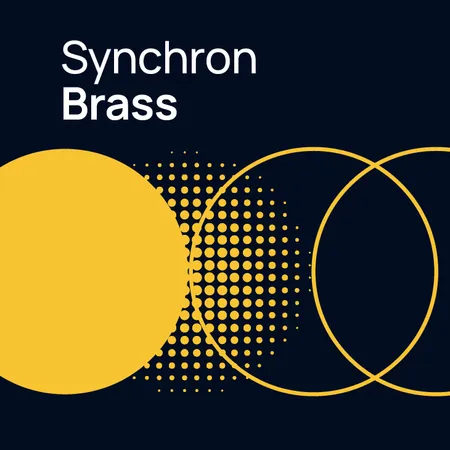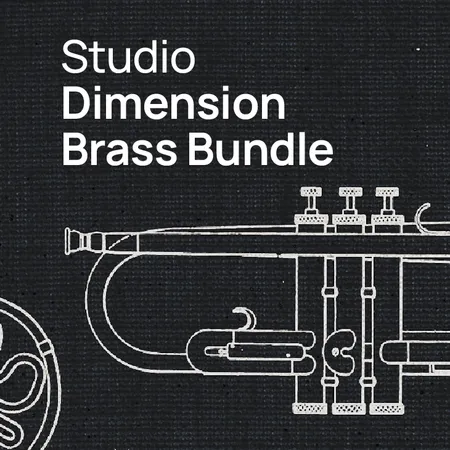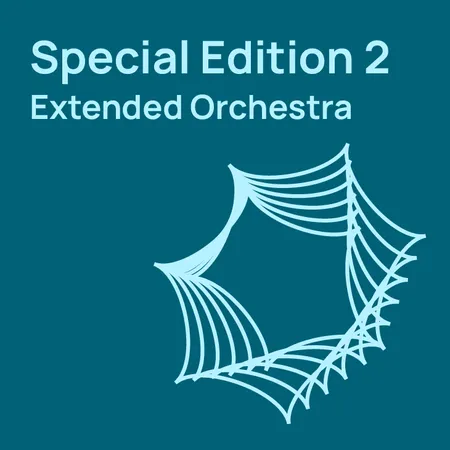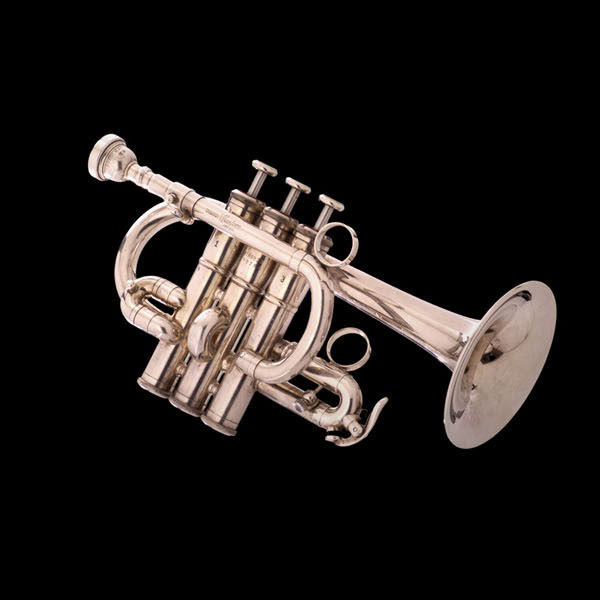
Name: Piccolo trumpet in high Bb/A
Spelling
German: Piccolotrompete
French: Petite Trompette
Italian: Tromba Piccola
Classification: Aerophone, brass wind instrument
Material: Brass (tubing), gold brass (leadpipe)
Mouthpiece: Small cup-shaped mouthpiece
Tubing: Length 65-72 cm, predominantly cylindrical; coiled form "A" tube (transposition to A)
Bore: Narrow, inner diameter 10.4-11 mm
Valves: Three valves, Périnet system
Bell: Rim diameter 9.4-10 cm
The name piccolo trumpet is given to all trumpets pitched from D through high Bb.
Today, the piccolo trumpet is used for orchestral playing mainly when the trumpet part is permanently in a very high register, e.g. for the performance of baroque clarino parts in Bach and Handel.
In terms of technique the playing of high trumpet parts on the piccolo trumpet cannot be compared to playing them on historical baroque trumpets:
The tubing of baroque trumpets was twice as long as that of modern trumpets - thus the fundamental of a baroque trumpet in C was an octave deeper than today’s C trumpet. Since the air column to be vibrated was twice as long, the instrument was far more difficult to play. In fact, a special clarino mouthpiece had to be used so that the high naturals in the clarino register (from the 8th partial) could be reached at all. The short tubing of modern trumpets and especially the piccolo trumpet means that they are considerably easier to play and that the chances of hitting the high notes accurately are much greater. No special mouthpiece is required. Therefore the performance of high-pitched baroque clarino parts on a modern piccolo trumpet cannot be compared to playing baroque clarino wind instruments. The common description in everyday usage of the piccolo trumpet as the Bach trumpet or clarino trumpet is therefore inaccurate.
Discover our Trumpets
Lining up overtones one behind the other produces the series of overtones. The overtones are also known as "harmonics". As always in acoustics, the ratio of partials vibrations with each other is given from low to high.
The numerical relationship between the harmonic partials (overtones) was dicovered by Pythagoras (approx. 500 B.C.). Over the course of history they became the mathematical basis of the Western theory of intervals.
High register valve trumpets were first made in the second half of the 19th century so that baroque clarino parts could once again be played.
In the 1880s the German trumpeter Julius Kosleck began playing baroque trumpet parts on a straight-tubed trumpet in A with two valves. From the 1890s, trumpets in high Eb/D and F/Eb were made in Belgium, but failed to gain widespread acceptance - in 1905, for instance, Richard Strauss (1864-1949) recommended the use of metal clarinets in Eb for the baroque trumpet parts in the extended and revised version of Berlioz’s instrumentation theory (!).
In 1905 Victor Charles Mahillon (1841-1925) developed a piccolo trumpet in high Bb with the fundamental Bb3. This instrument achieved general acceptance in the 1960s.
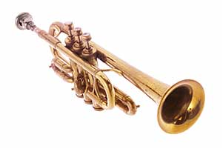
Périnet valve trumpet in Bb, The H.N. White Co., Cleveland, Ohio, ca. 1931. The world's smallest playable Périnet valve trumpet (Musikinstrumentenmuseum Schloss Kremsegg, Austria, Streitwieser collection)
Nowadays many jazz trumpeters try to follow the example of the baroque clarino wind players by pushing the trumpet’s range to higher and higher registers. Cat Anderson and Maynard Ferguson are two of the most influential jazz trumpeters to have reached the heights of the third and even fourth octaves above middle C. Miles Davis and Wynton Marsalis are well-known for their efforts to incorporate elements of serious music into jazz.
Music for the piccolo trumpet in high Bb/A is notated in treble clef. It is a transposing instrument, and sounds either a minor seventh (Bb tuning) or a major sixth (A tuning) higher than written.
Range of the piccolo trumpet in high Bb: D4 - G6
The range of the piccolo trumpet in high Bb is approximately an octave higher than that of the Bb trumpet.
It is not necessary to differentiate between registers because the timbre is homogeneous over the whole range.
As with all trumpets (with the exception of the bass trumpet) the natural harmonic series (scale of partials) is only used from the 2nd partial, since the 1st partial cannot be intoned clearly.
In the low register E4 is reached from the 2nd natural by closing all three valves. By depressing the 4th valve even D4 can be reached. This means that two additional half tones are gained (in the A tuning even C#4 can theoretically be played).
As a rule the scale goes up to G6 (8th partial with the 3rd valve depressed). Trumpet virtuosos can reach even higher notes, but the piercing quality of notes at this pitch is very rarely called for in orchestral literature.
Thanks to the ease of its playability the trumpet possesses remarkable technical agility. Extemporaneous playing of the highest notes is possible, as are large legato and staccato leaps.
Can be played with great precision at the fastest tempi, and at extreme dynamic levels and with dynamic changes in accidentals.
Sforzando
Forced, short attack followed by a rapid reduction in tone intensity.
Sforzandissimo
Forced, short attack with continuance of tone intensity.
Fortepiano
Rapid dynamic reduction from forte to piano.
Can be played with great precision at the fastest tempi, and at extreme dynamic levels and with dynamic changes in accidentals.
Can be played with great precision at the fastest tempi, and at extreme dynamic levels and with dynamic changes in accidentals.
While playing the musician flutters his tongue between his lips. It is rarely used, since it produces a piercing and overstated sound, particularly when played with a mute.
On the trumpet the trill is one of the less refined techniques and is therefore rarely used.
Lends the tone more intensity.
Piano: very gentle, glassy and subtle;Fortissimo: shrill, piercing, cutting.
Thanks to the agility of the trumpet runs can be produced very easily.
The piccolo trumpet has a sound which exhibits all the typical characteristics of the trumpet, although it is brighter and clearer than the C trumpet.
The sound is particularly homogenous in all areas and it is not necessary to differentiate between registers since there are no noticeable abrupt changes in timbre between the powerful notes in the lower register and the sharp, strident high notes. The instrument’s easy response means that the full sound is achieved immediately after blowing. The sound develops best between C5 and C6.
The extreme clarity and brilliance of the piccolo trumpet makes it ideal as a solo instrument, but in 20th century orchestration piccolo trumpets of various pitches are often used to flesh out the sound, in unison with the oboes, for instance.
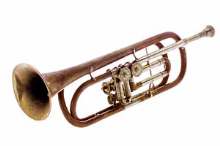
Bach trumpet in F, Mainz, Germany, brothers Alexander, perhaps 1952. Specially developed in 1934 for performances of J.S. Bach’s music (Musikinstrumentenmuseum Schloss Kremsegg, Austria, Streitwieser collection)
The golden age of high-pitched trumpets was the baroque period. For baroque musicians, the sound ideal was the human voice. The clarino notes, which were extremely difficult to play on the long baroque trumpet, sounded delicate and clear, like a flute, and resembled the treble, the highest-pitched singing voice of the period, more than any other instrument. The baroque clarino notes are the next step in taking the human voice up toward heaven, and thus symbolize man’s striving for God.
In this quest for perfection the art of clarino playing - of playing the highest naturals in the trumpet’s range - was literally carried to new heights.
The clarino playing technique gradually replaced deep military trumpets as symbols of court representation. The higher-pitched trumpets were regarded as refined and noble; clarino playing was associated with high standing and social status, because the musicians played at court - for emperors and princes - and not for the “peasant rabble”.
Maurice Ravel
- Boléro (1928), for picc. in D
Igor Stravinsky
- The Rite of Spring (1913), for picc. in D
- Symphony of Psalms (1930), for picc. in D
Hans Werner Henze
- 6th symphony (1969)
- Claudio Monteverdi L’Orfeo (Toccata, 1609)
- Girolamo Fantini (1600-1675)
- Clement Thieme (1631-1668)
- Johann Ch. Pezel (1639-1694)
- Pavel J. Vejvanovsky (1640-1693)
- Heinrich I. F. Biber (1644-1704)
- Ferdinand T. Richter (1649-1711)
- Arcangelo Corelli (1653-1713)
- Giuseppe Torelli (1658-1709)
- Domenico Gabrieli (1659-1690)
- Henry Purcell (1659-1695)
- Antonio Vivaldi (1678-1741)
- Johann J. Schnell (1687-1754)
- Georg Philipp Telemann (1681-1767)
- Georg Friedrich Händel (1685-1759)
- Johann Sebastian Bach (1685-1750)
- Johann F. Fasch (1688-1758)
- Johann S. Endler (1694-1762)
- Johann M. Molter (1696-1765)
- Joseph A. Gross (1701-1784)
- Franz X. Richter (1709-1789)
- Joseph Riepel (1709-1782)
- J. G. Leopold Mozart (1719-1787)
- Johann W. Hertel (1727-1789)
- Carl F. Ch. Fasch (1736-1800)
- Johann M. Sperger (1750-1812)
André Jolivet
- 2nd trumpet concerto (1954)
Boris Blacher
- Concerto for high trumpet and string orchestra (1970)
Hans Werner Henze
- Sonatina for eight brass instruments (1983), for picc. in G
Karlheinz Stockhausen
- Luzifers Tanz (excerpts from the opera Licht, arranged for brass ensemble, 1983)
Mauricio Kagel
- Fanfaren for 4 trumpets (1993)
On this page
- Overtones
- History
- Notation
- Range
- Sound production
- Playing Techniques
- General
- Single Tonguing
- Vibrato
- Sforzato
- Double tonguing
- Triple tonguing
- Flutter tonguing
- Trills
- Mute
- Runs
- Phrases
- Sound characteristics
- Sound Combinations
- Symbolism
- Repertoire (selection)
- Operas and symphonic works
- Piccolo trumpet and orchestra
- Chamber music
